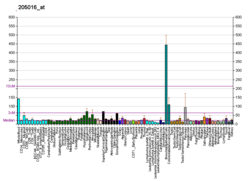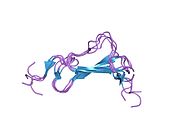TGF 알파
TGF alpha| TGFA | |||||||||||||||||||||||||
|---|---|---|---|---|---|---|---|---|---|---|---|---|---|---|---|---|---|---|---|---|---|---|---|---|---|
 | |||||||||||||||||||||||||
| |||||||||||||||||||||||||
| 식별자 | |||||||||||||||||||||||||
| 별칭 | TGFA, TFGA, 변환성장인자 알파, 변환성장인자 - α | ||||||||||||||||||||||||
| 외부 ID | OMIM: 190170 MGI: 98724 HomoloGene: 2431 GeneCard: TGFA | ||||||||||||||||||||||||
| |||||||||||||||||||||||||
| |||||||||||||||||||||||||
| |||||||||||||||||||||||||
| |||||||||||||||||||||||||
| 직교체 | |||||||||||||||||||||||||
| 종 | 인간 | 마우스 | |||||||||||||||||||||||
| 엔트레스 | |||||||||||||||||||||||||
| 앙상블 | |||||||||||||||||||||||||
| 유니프로트 | |||||||||||||||||||||||||
| RefSeq(mRNA) | |||||||||||||||||||||||||
| RefSeq(단백질) | |||||||||||||||||||||||||
| 위치(UCSC) | Chr 2: 70.45 – 70.55Mb | Chr 6: 86.17 – 86.25Mb | |||||||||||||||||||||||
| PubMed 검색 | [3] | [4] | |||||||||||||||||||||||
| 위키다타 | |||||||||||||||||||||||||
| |||||||||||||||||||||||||
변환성장인자 알파(TGF-α)는 인간에서 TGFA 유전자에 의해 인코딩되는 단백질이다.[5]표피 성장인자(EGF) 계열의 일원으로서 TGF-α는 미생성 폴리펩타이드다.[6]단백질은 세포신호를 위해 단백질 키나제 활성이 가능한 수용체에 결합할 때 활성화된다.
TGF-α는 표피 성장인자 수용체용 리간드인 변환성장인자로 세포 증식과 분화, 발달을 위한 신호통로를 활성화한다.이 단백질은 투과성 결합 리간드 또는 용해성 리간드로 작용할 수 있다.이 유전자는 많은 종류의 암과 연관되어 왔으며, 몇몇 구순열/구개열 사례에도 관련될 수 있다.[5]
합성
TGF-α는 160(인간) 또는 159(랫드) 아미노산 투과 전구체의 일부로 내부적으로 합성된다.[7]전구체는 소수성 투과형 영역, TGF-α의 아미노산 50개, 35-리시듀-긴 세포질 영역을 포함하는 세포외 영역으로 구성된다.[7]TGF-α는 가장 작은 형태로 이황화 교량 3개를 통해 6개의 시스테인이 서로 연결되어 있다.집합적으로 EGF/TGF-α 계열의 모든 구성원이 이 구조를 공유한다.그러나 이 단백질은 TGF-β와 직접 관련이 없다.
제한된 성공은 유사한 생물학적 프로파일을 표시하는 TGF-α에 환원제 분자를 합성하려는 시도에서 비롯되었다.[8]
위 속의 합성
위에서는 정상 위점막 내에서 TGF-α가 제조된다.[9]TGF-α는 위산 분비를 억제하는 것으로 나타났다.
함수
TGF-α는 대식세포, 뇌세포, 각질세포에서 생성될 수 있다.TGF-α는 상피 발달을 유도한다.TGF-α가 EGF 계열의 일원임을 고려하면 TGF-α와 EGF의 생물학적 작용은 유사하다.예를 들어, TGF-α와 EGF는 동일한 수용체에 결합한다.TGF-α가 EGFR에 결합할 때 그것은 다중 세포 확산 사건을 시작할 수 있다.[8]EGFR에 묶인 TGF-α와 관련된 세포 증식 사건에는 상처 치유와 발생이 포함된다.TGF-α는 종양 발생에도 관여하며 혈관신생을 촉진하는 것으로 알려져 있다.[7]
TGF-α는 또한 성인 부상당한 뇌에서 신경 세포 증식을 자극하는 것으로 나타났다.[10]
수용체
EGF 수용체로 알려진 170kDa 글리코실화 단백질은 TGF-α에 결합되어 폴리펩타이드의 다양한 신호 경로에서 기능할 수 있다.[6]EGF 수용체는 수많은 아미노산 모티브를 가진 세포외 영역을 갖는 것이 특징이다.EGFR은 단일 전송 영역, 세포 내 영역(티로신 키나제 활동 포함), 리간드 인식에 필수적이다.[6]막 정박 성장 계수로서 TGF-α는 단백질 분해효소를 통해 적분막 당단백질에서 분리될 수 있다.[7]갈라짐으로 인한 TGF-α의 수용성 형태는 EGFR을 활성화할 수 있는 용량을 가지고 있다. EGFR은 막 부착 성장 계수에서도 활성화될 수 있다.
TGF-α가 EGFR에 결합하면 단백질-티로신 키나아제의 인산화를 촉발하는 감광 효과가 있다.단백질-티로신 키나아제의 활성은 EGFR 내의 여러 티로신 잔류물들 사이에서 자가인산화를 유발하여 많은 신호 전달 경로에서 상호작용하는 다른 단백질의 활성화와 신호에 영향을 미친다.

동물학
도파민성 뉴런이 6-하이드록시도파민에 의해 손상된 파킨슨병 동물 모델에서 TGF-α를 뇌에 주입하면 뉴런 전구세포의 수가 증가하였다.[10]그러나 TGF-α 치료는 도파민성 뉴런의 신경유전증을 유발하지 않았다.[11]
인간학
신경내분비계
EGF/TGF-α 계열은 글루티뉴런 인터랙티브 과정을 통해 루틴화 호르몬(LHRH)을 조절하는 것으로 나타났다.[6]저체온성 아스트로시테스에서 생산되는 TGF-α는 다양한 매개체를 통해 간접적으로 LHRH 방출을 자극한다.그 결과 TGF-α는 여성 사춘기의 시작 과정에 필수적인 생리학적 성분이다.[6]
수프라치즘핵
TGF-α는 또한 초거대성핵 (SCN) (5)에서 고도로 표현되는 것으로 관찰되었다.이 결과는 SCN 내의 클락과 순환 리듬의 조절에서 EGFR 신호에 대한 역할을 시사한다.[12]제3심실 TGF-α에 주사하면 음주나 식사 활동과 함께 순환식 기관차 행동을 억제할 수 있다는 유사한 연구결과가 나왔다.[12]
종양
이 단백질은 위암과 같은 다양한 종양에서 예후성 바이오마커로서 잠재적인 사용을 보여준다.[13]또는 흑색종이 제안되었다.[14]TGF-α 상승은 위장의 전치사인 메네티어 병과 관련이 있다.[15]
상호작용
TGF 알파는 GORASP1[16] 및 GORASP2와 상호작용하는 것으로 나타났다.[16]
참고 항목
참조
- ^ a b c GRCh38: 앙상블 릴리스 89: ENSG00000163235 - 앙상블, 2017년 5월
- ^ a b c GRCm38: 앙상블 릴리스 89: ENSMUSG000029999 - 앙상블, 2017년 5월
- ^ "Human PubMed Reference:". National Center for Biotechnology Information, U.S. National Library of Medicine.
- ^ "Mouse PubMed Reference:". National Center for Biotechnology Information, U.S. National Library of Medicine.
- ^ a b "Entrez Gene: TGFA transforming growth factor alpha".
- ^ a b c d e Ojeda, S. R.; Ma, Y. J.; Rage, F. (September 1997). "The transforming growth factor alpha gene family is involved in the neuroendocrine control of mammalian puberty". Molecular Psychiatry. 2 (5): 355–358. doi:10.1038/sj.mp.4000307. PMID 9322223.
- ^ a b c d 페러, I.; 알칸타라, S.; 발라브리가, J.; 올리브, M.; 블랑코, R.; 리베라, R.; 카르모나, M.; 베르루조, M.; 피타르크, S.; 플라나스, A.정상 및 병리학적 뇌에서 성장 인자-α(TGF-α) 및 표피 성장 인자-수용체(EGF-R) 면역 활성 변환.프로그, 신경생물 96, 49, 99
- ^ a b McInnes, C; Wang, J; Al Moustafa, AE; Yansouni, C; O'Connor-McCourt, M; Sykes, BD (1998). "Structure-based minimization of transforming growth factor-alpha (TGF-alpha) through NMR analysis of the receptor-bound ligand. Design, solution structure, and activity of TGF-alpha 8-50"". J. Biol. Chem. 273 (42): 27357–63. doi:10.1074/jbc.273.42.27357. PMID 9765263.
- ^ 코피, R, 강가로사, L.; 담스트립, L.; 뎀프시, P. 성장인자 α 및 관련 펩타이드 변환의 기본 작용.유러 J 위스텐간, 1995년 7월 923일
- ^ a b Fallon J, Reid S, Kinyamu R, Opole I, Opole R, Baratta J, Korc M, Endo TL, Duong A, Nguyen G, Karkehabadhi M, Twardzik D, Patel S, Loughlin S (2000). "In vivo induction of massive proliferation, directed migration, and differentiation of neural cells in the adult mammalian brain". Proceedings of the National Academy of Sciences of the United States of America. 97 (26): 14686–91. Bibcode:2000PNAS...9714686F. doi:10.1073/pnas.97.26.14686. PMC 18979. PMID 11121069.
{{cite journal}}: CS1 maint: 작성자 매개변수 사용(링크) - ^ Cooper O, Isacson O (October 2004). "Intrastriatal transforming growth factor alpha delivery to a model of Parkinson's disease induces proliferation and migration of endogenous adult neural progenitor cells without differentiation into dopaminergic neurons". J. Neurosci. 24 (41): 8924–31. doi:10.1523/JNEUROSCI.2344-04.2004. PMC 2613225. PMID 15483111.
- ^ a b Hao, H.; Schwaber, J. 표피 성장 인자 수용체가 초혈성 핵에서 에르크 인산화를 유도했다.브레인 리스 2006, 1088, 45
- ^ Fanelli MF (Aug 2012). "The influence of transforming growth factor-α, cyclooxygenase-2, matrix metalloproteinase (MMP)-7, MMP-9 and CXCR4 proteins involved in epithelial-mesenchymal transition on overall survival of patients with gastric cancer". Histopathology. 61 (2): 153–61. doi:10.1111/j.1365-2559.2011.04139.x. PMID 22582975. S2CID 6566296.
- ^ Tarhini AA (Jan 2014). "A four-marker signature of TNF-RII, TGF-α, TIMP-1 and CRP is prognostic of worse survival in high-risk surgically resected melanoma". J Transl Med. 12: 19. doi:10.1186/1479-5876-12-19. PMC 3909384. PMID 24457057.
- ^ Coffey, Robert J.; Washington, Mary Kay; Corless, Christopher L.; Heinrich, Michael C. (2007). "Ménétrier disease and gastrointestinal stromal tumors: hyperproliferative disorders of the stomach". Journal of Clinical Investigation. 117 (1): 70–80. doi:10.1172/JCI30491. PMC 1716220. PMID 17200708.
- ^ a b Barr FA, Preisinger C, Kopajtich R, Körner R (December 2001). "Golgi matrix proteins interact with p24 cargo receptors and aid their efficient retention in the Golgi apparatus". J. Cell Biol. 155 (6): 885–91. doi:10.1083/jcb.200108102. PMC 2150891. PMID 11739402.
추가 읽기
- Luetteke NC, Lee DC (1991). "Transforming growth factor alpha: expression, regulation and biological action of its integral membrane precursor". Semin. Cancer Biol. 1 (4): 265–75. PMID 2103501.
- Greten FR, Wagner M, Weber CK, Zechner U, Adler G, Schmid RM (2002). "TGF alpha transgenic mice. A model of pancreatic cancer development". Pancreatology. 1 (4): 363–8. doi:10.1159/000055835. PMID 12120215. S2CID 84256727.
- Vieira AR (2006). "Association between the transforming growth factor alpha gene and nonsyndromic oral clefts: a HuGE review". Am. J. Epidemiol. 163 (9): 790–810. doi:10.1093/aje/kwj103. PMID 16495466.
- Nasim MM, Thomas DM, Alison MR, Filipe MI (1992). "Transforming growth factor alpha expression in normal gastric mucosa, intestinal metaplasia, dysplasia and gastric carcinoma--an immunohistochemical study". Histopathology. 20 (4): 339–43. doi:10.1111/j.1365-2559.1992.tb00991.x. PMID 1577411. S2CID 73067240.
- Thomas DM, Nasim MM, Gullick WJ, Alison MR (1992). "Immunoreactivity of transforming growth factor alpha in the normal adult gastrointestinal tract". Gut. 33 (5): 628–31. doi:10.1136/gut.33.5.628. PMC 1379291. PMID 1612477.
- Bean MF, Carr SA (1992). "Characterization of disulfide bond position in proteins and sequence analysis of cystine-bridged peptides by tandem mass spectrometry". Anal. Biochem. 201 (2): 216–26. doi:10.1016/0003-2697(92)90331-Z. PMID 1632509.
- Lei ZM, Rao CV (1992). "Expression of epidermal growth factor (EGF) receptor and its ligands, EGF and transforming growth factor-alpha, in human fallopian tubes". Endocrinology. 131 (2): 947–57. doi:10.1210/en.131.2.947. PMID 1639032.
- Werner S, Roth WK, Bates B, Goldfarb M, Hofschneider PH (1991). "Fibroblast growth factor 5 proto-oncogene is expressed in normal human fibroblasts and induced by serum growth factors". Oncogene. 6 (11): 2137–44. PMID 1658709.
- Saeki T, Cristiano A, Lynch MJ, Brattain M, Kim N, Normanno N, Kenney N, Ciardiello F, Salomon DS (1992). "Regulation by estrogen through the 5'-flanking region of the transforming growth factor alpha gene". Mol. Endocrinol. 5 (12): 1955–63. doi:10.1210/mend-5-12-1955. PMID 1791840.
- Harvey TS, Wilkinson AJ, Tappin MJ, Cooke RM, Campbell ID (1991). "The solution structure of human transforming growth factor alpha". Eur. J. Biochem. 198 (3): 555–62. doi:10.1111/j.1432-1033.1991.tb16050.x. PMID 2050136.
- Kline TP, Brown FK, Brown SC, Jeffs PW, Kopple KD, Mueller L (1991). "Solution structures of human transforming growth factor alpha derived from 1H NMR data". Biochemistry. 29 (34): 7805–13. doi:10.1021/bi00486a005. PMID 2261437.
- Jakowlew SB, Kondaiah P, Dillard PJ, Sporn MB, Roberts AB (1989). "A novel low molecular weight ribonucleic acid (RNA) related to transforming growth factor alpha messenger RNA". Mol. Endocrinol. 2 (11): 1056–63. doi:10.1210/mend-2-11-1056. PMID 2464748.
- Jakobovits EB, Schlokat U, Vannice JL, Derynck R, Levinson AD (1989). "The human transforming growth factor alpha promoter directs transcription initiation from a single site in the absence of a TATA sequence". Mol. Cell. Biol. 8 (12): 5549–54. doi:10.1128/mcb.8.12.5549. PMC 365660. PMID 2907605.
- Tricoli JV, Nakai H, Byers MG, Rall LB, Bell GI, Shows TB (1986). "The gene for human transforming growth factor alpha is on the short arm of chromosome 2". Cytogenet. Cell Genet. 42 (1–2): 94–8. doi:10.1159/000132258. PMID 3459638.
- Lee DC, Rose TM, Webb NR, Todaro GJ (1985). "Cloning and sequence analysis of a cDNA for rat transforming growth factor-alpha". Nature. 313 (6002): 489–91. Bibcode:1985Natur.313..489L. doi:10.1038/313489a0. PMID 3855503. S2CID 4358296.
- Derynck R, Roberts AB, Winkler ME, Chen EY, Goeddel DV (1984). "Human transforming growth factor-alpha: precursor structure and expression in E. coli". Cell. 38 (1): 287–97. doi:10.1016/0092-8674(84)90550-6. PMID 6088071. S2CID 53275849.
- Ogbureke KU, MacDaniel RK, Jacob RS, Durban EM (1995). "Distribution of immunoreactive transforming growth factor-alpha in non-neoplastic human salivary glands". Histol. Histopathol. 10 (3): 691–6. PMID 7579819.
- Walz TM, Malm C, Nishikawa BK, Wasteson A (1995). "Transforming growth factor-alpha (TGF-alpha) in human bone marrow: demonstration of TGF-alpha in erythroblasts and eosinophilic precursor cells and of epidermal growth factor receptors in blastlike cells of myelomonocytic origin". Blood. 85 (9): 2385–92. doi:10.1182/blood.V85.9.2385.bloodjournal8592385. PMID 7727772.
- Patel B, Hiscott P, Charteris D, Mather J, McLeod D, Boulton M (1994). "Retinal and preretinal localisation of epidermal growth factor, transforming growth factor alpha, and their receptor in proliferative diabetic retinopathy". The British Journal of Ophthalmology. 78 (9): 714–8. doi:10.1136/bjo.78.9.714. PMC 504912. PMID 7947554.
외부 링크
이 기사는 공공영역에 있는 미국 국립 의학 도서관의 텍스트를 통합하고 있다.















